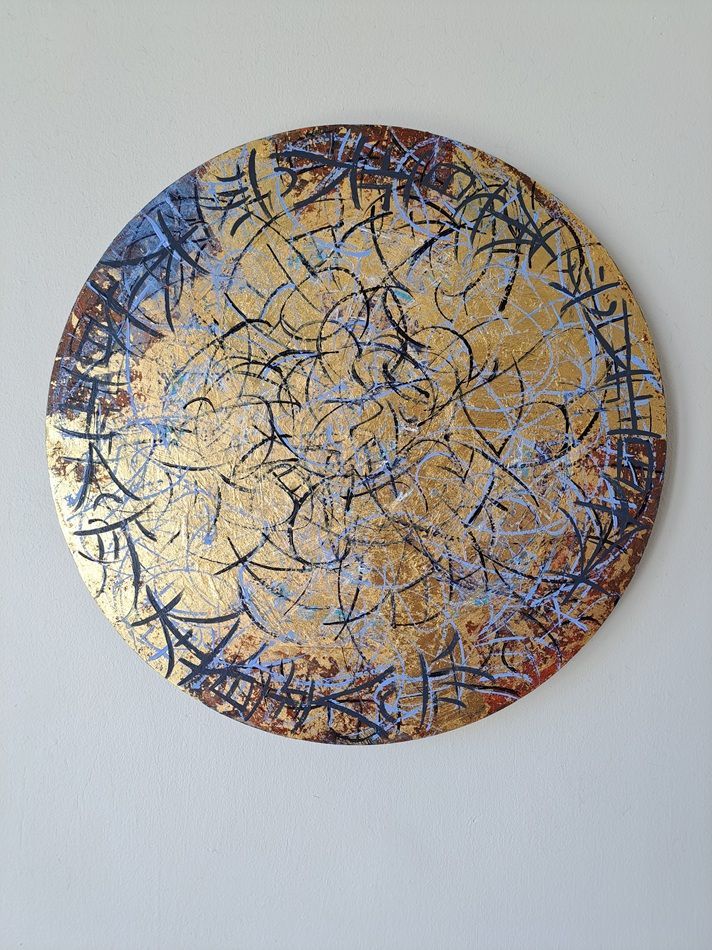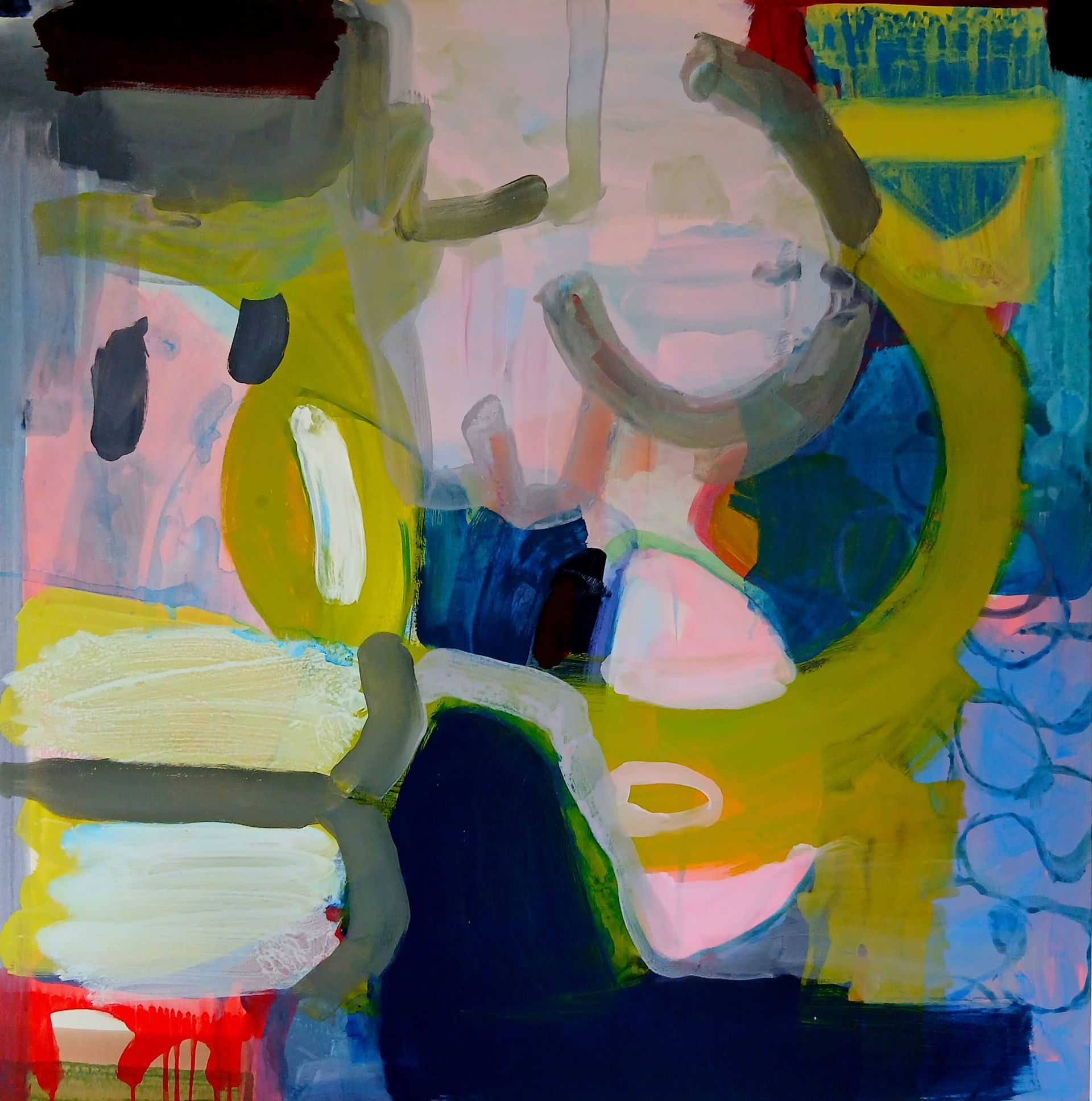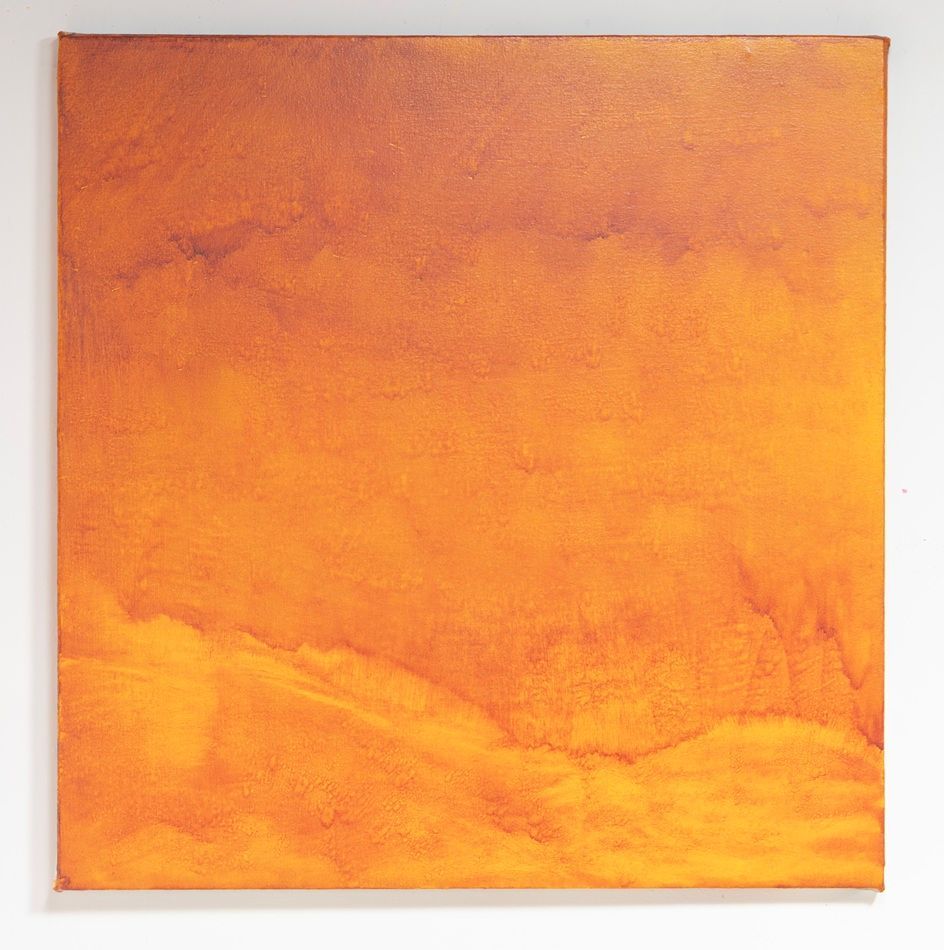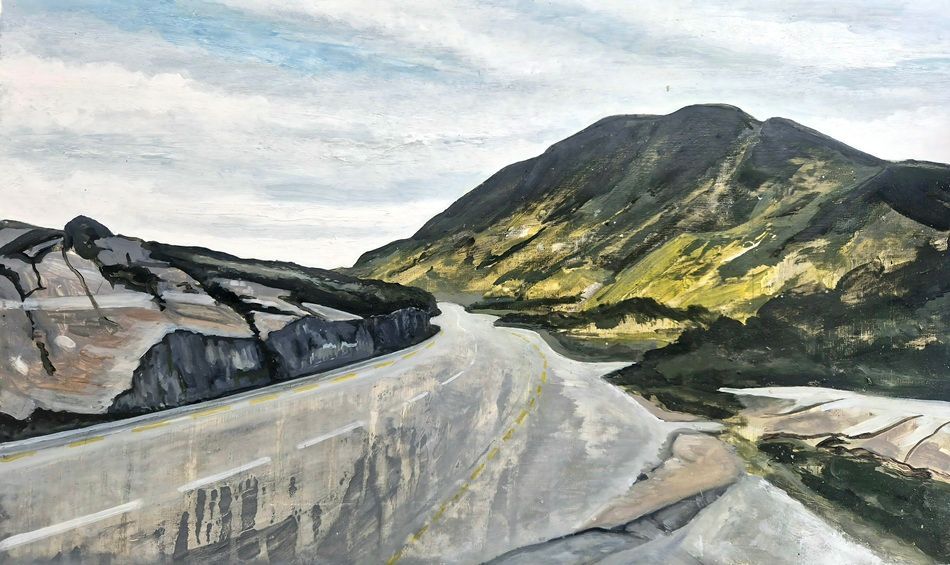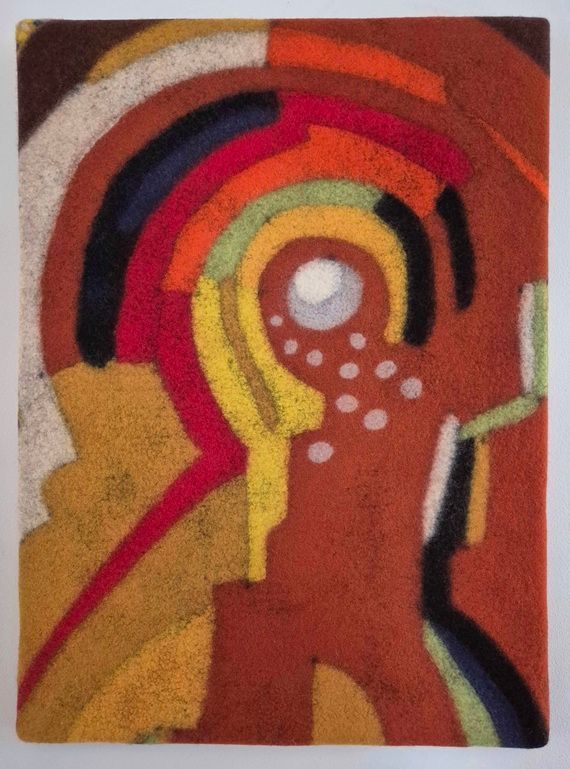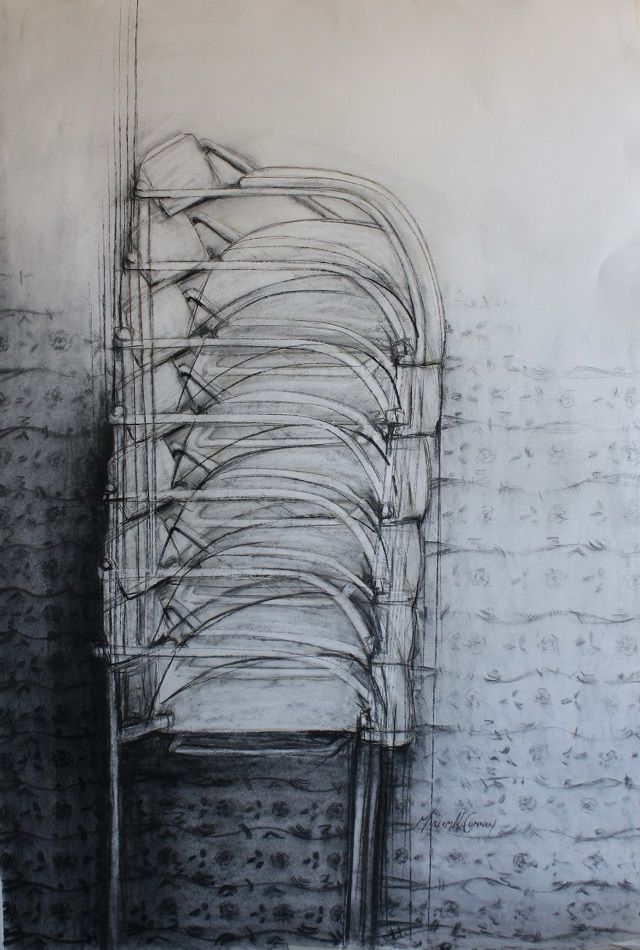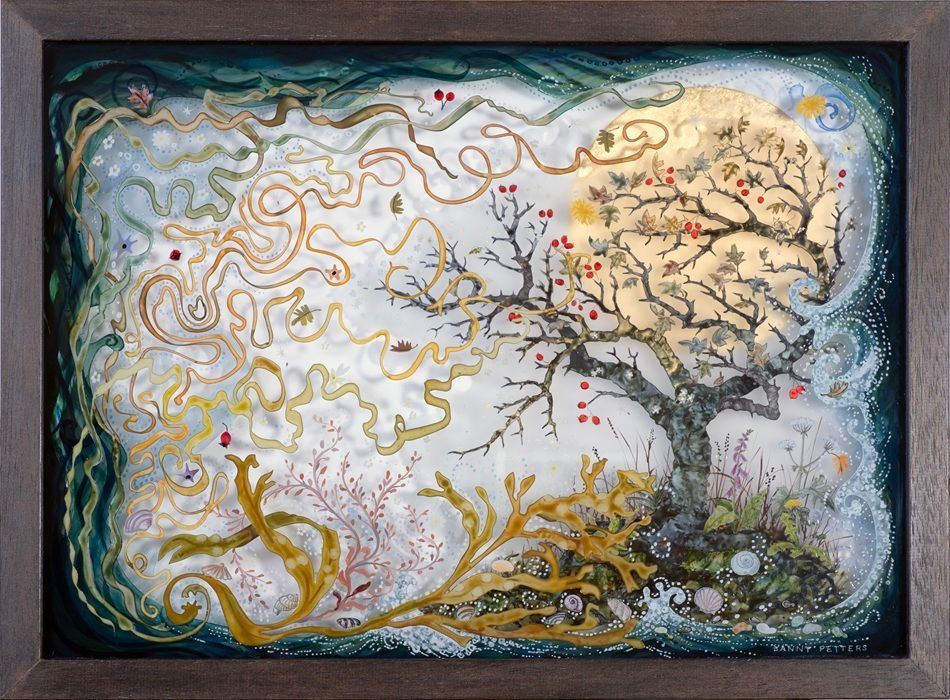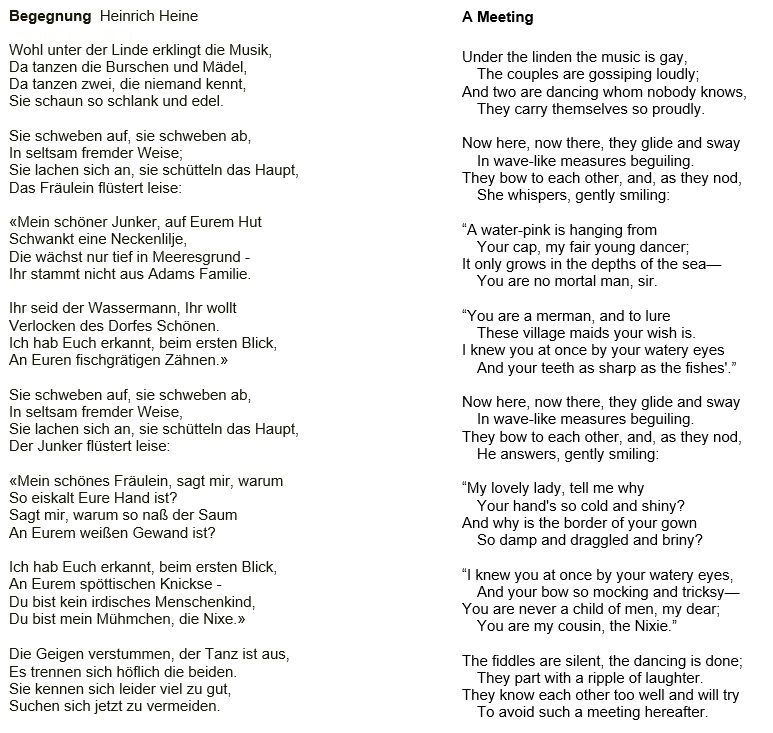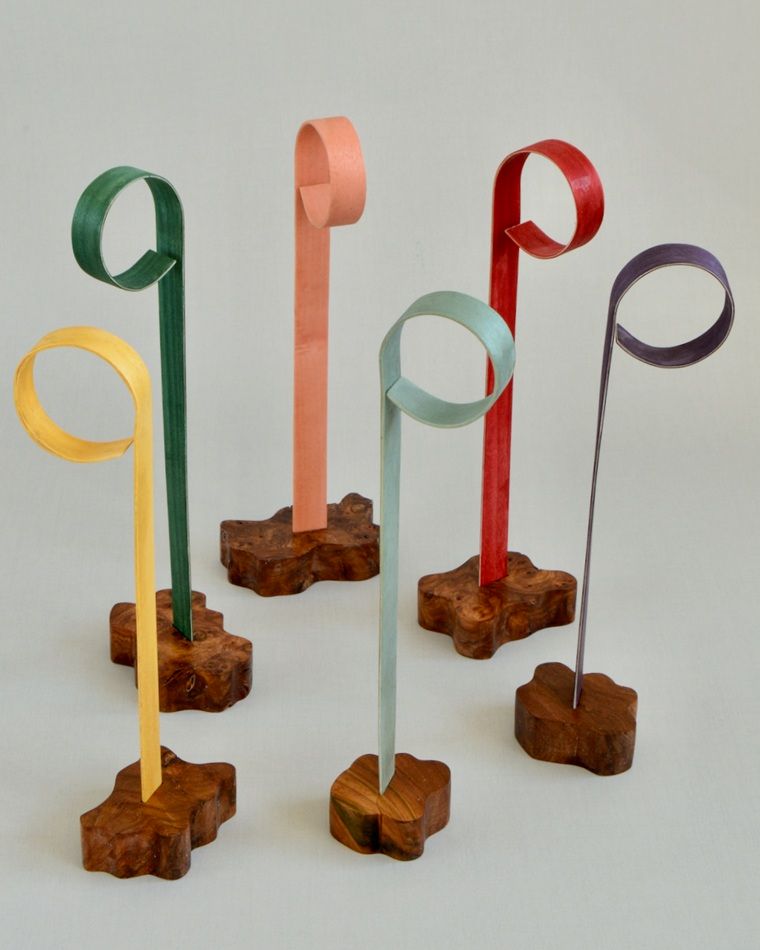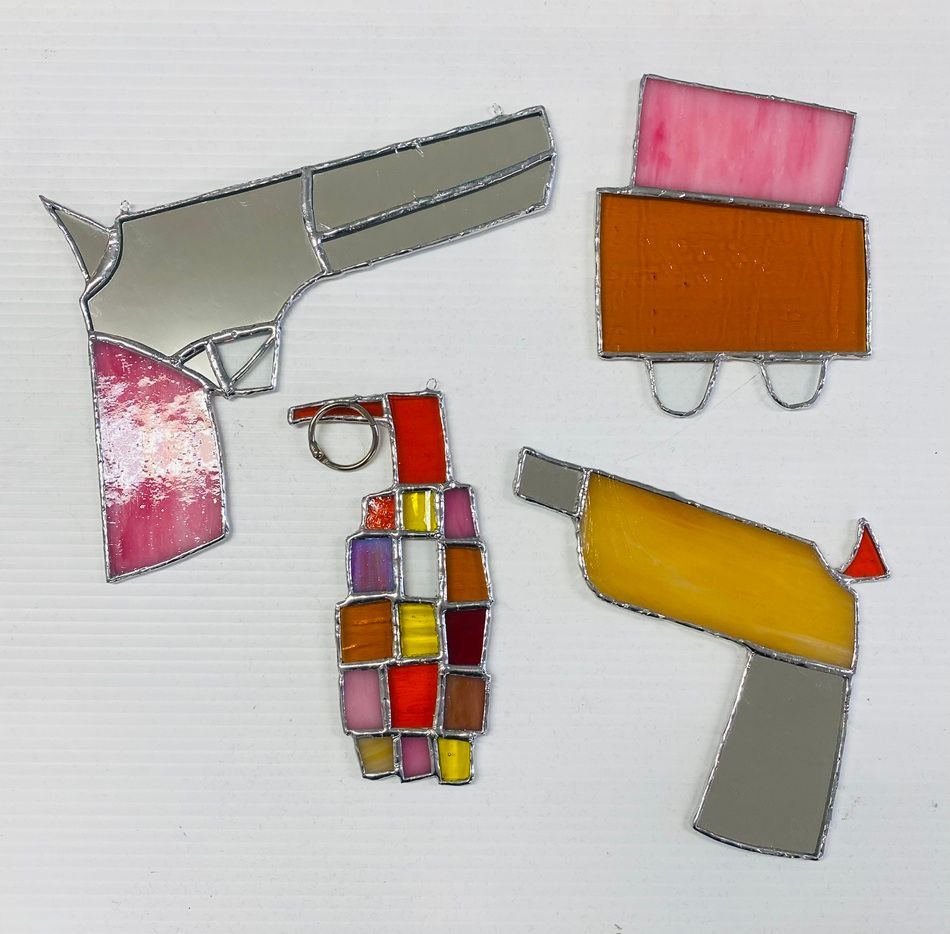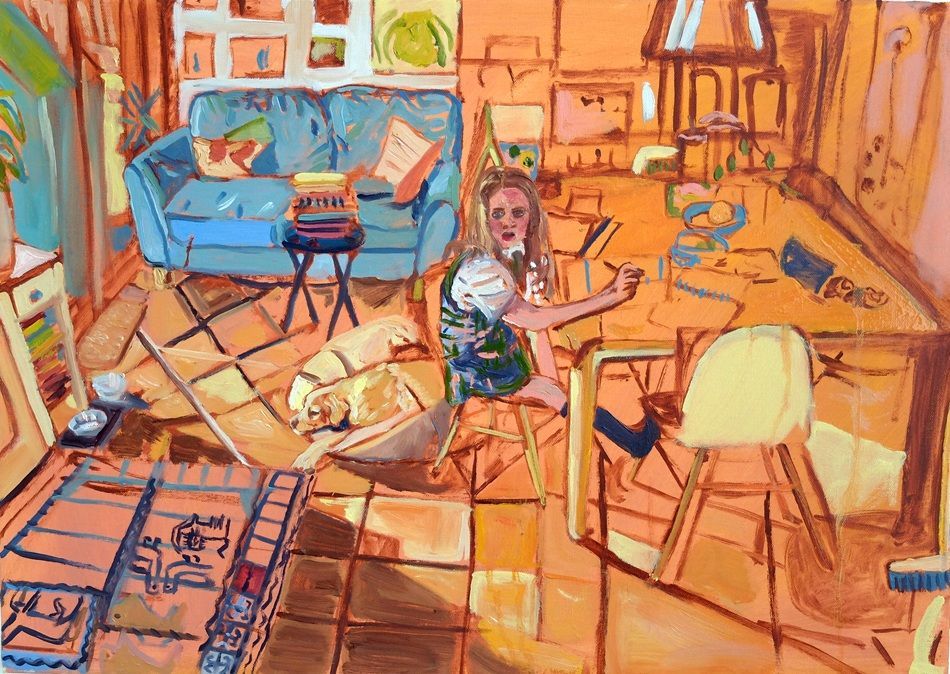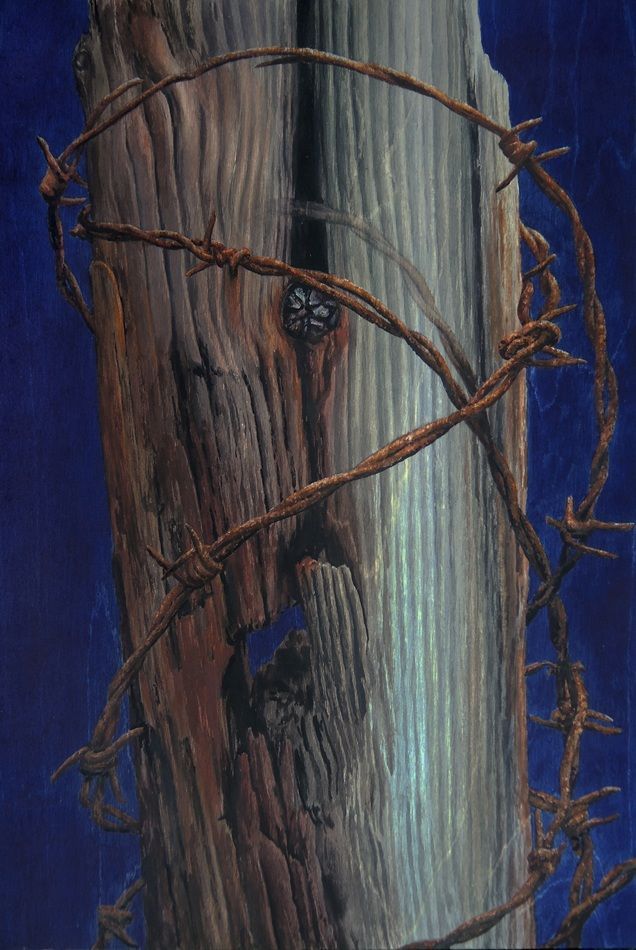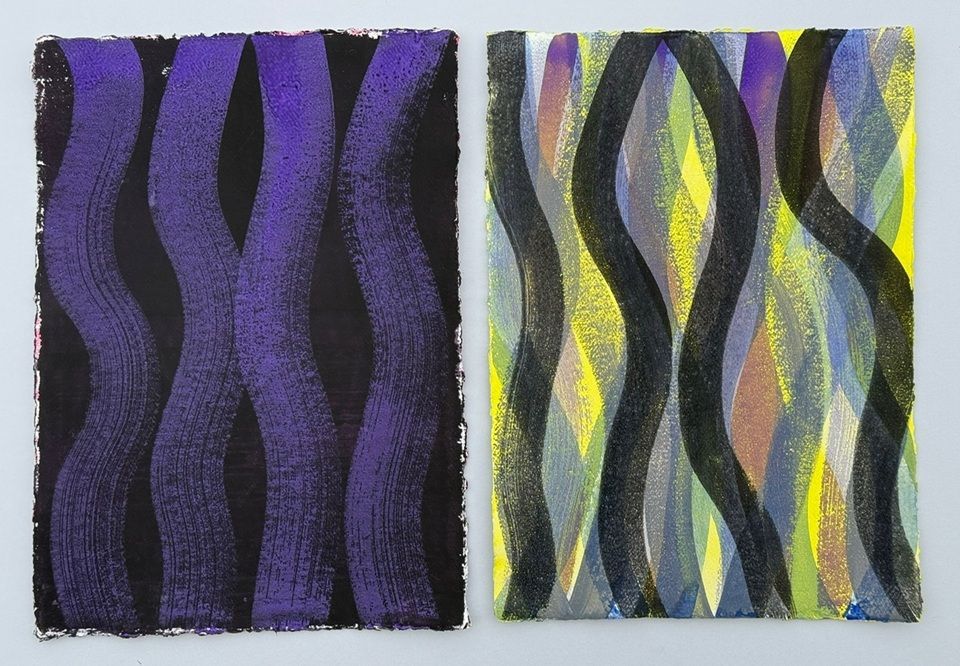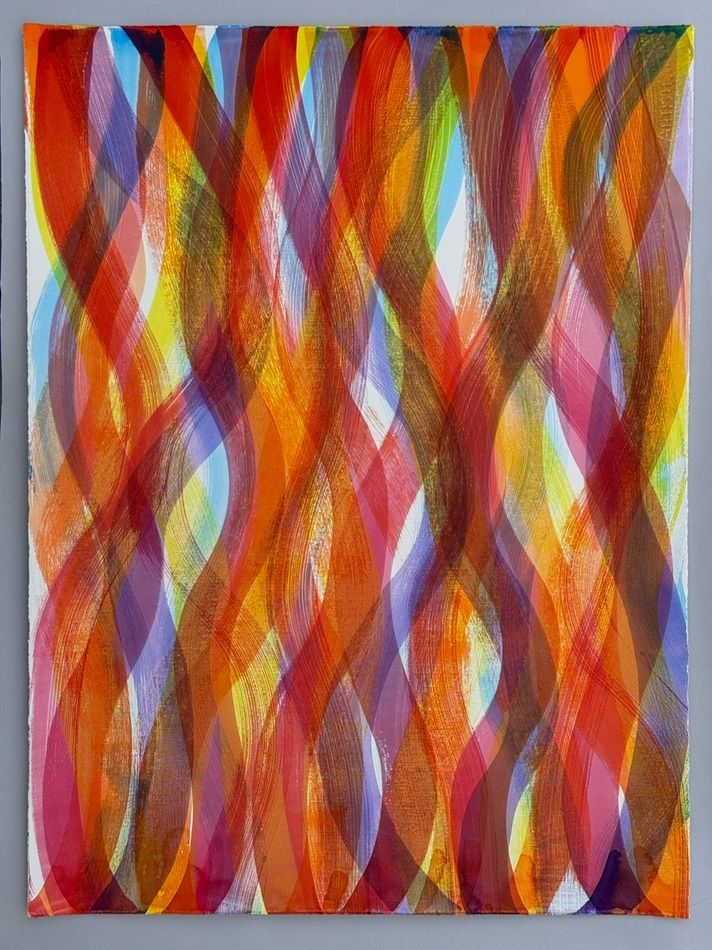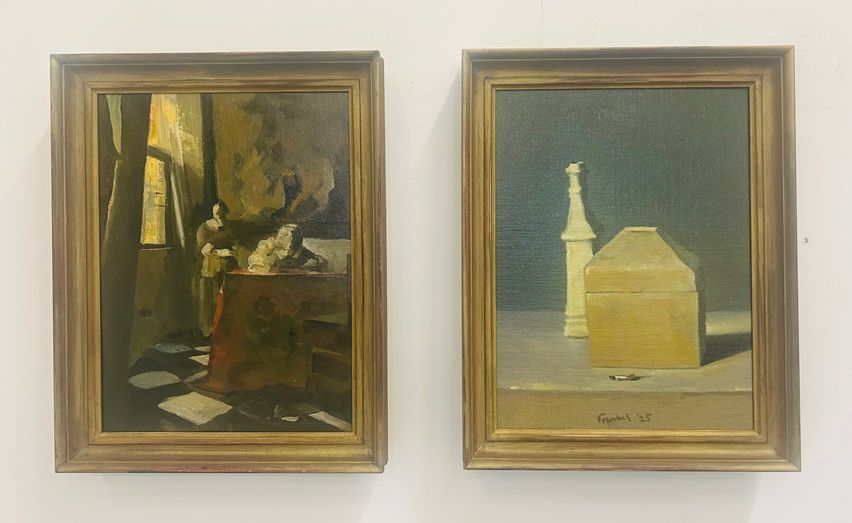'Ode to Giants', group show - 7 November to 7 December 2025
Artists: Annika Berglund, Hugh Cummins, Mary A. Fitzgerald, David Fox, Conrad Frankel, Nickie Hayden, Eoin Mac Lochlainn, Miriam McConnon, Sheila Naughton, Bart O'Reilly, Yanny Petters, Kelly Ratchford and Vicky Smith.
Friday 7 November 2025, 6:30pm
| OCG artist | Responds to | by | Collection |
|---|---|---|---|
| Annika Berglund | An Abstract Composition | Mainie Jellett | National Gallery of Ireland |
| Hugh Cummins | Modus Magnus | Joseph Walsh | National Gallery of Ireland |
| Mary A. Fitzgerald | About to Write a Letter | Jack B. Yeats | National Gallery of Ireland |
| David Fox | Killarney, Co. Kerry | Paul Henry | IMMA |
| Conrad Frankel | Woman Writing a Letter, with her Maid | Johannes Vermeer | National Gallery of Ireland |
| Nickie Hayden | Meditation Painting 28 | Patrick Scott | IMMA |
| Eoin Mac Lochlainn | Ecce Homo | Titian | National Gallery of Ireland |
| Miriam McConnon | Non Conformist Chair | Eileen Gray | National Museum of Ireland |
| Sheila Naughton | Brush Strokes in all Directions | Sol LeWitt | IMMA |
| Bart O'Reilly | The Taking of Christ | Caravaggio | National Gallery of Ireland |
| Yanny Petters | A meeting | Harry Clarke | National Museum of Ireland |
| Kelly Ratchford | Incident and Border Incident | Willie Doherty | IMMA |
| Vicky Smith | Sacha and her mum | Gillian Wearing | IMMA |
Coverage/reviews:
- Bart O'Reilly presents the genesis of his response to Caravaggio's The Taking of Christ.
- DublinTown, 29 September 2025.
- The Dublin Gallery Weekend, Scéalta Ealaíne, Eoin Mac Lochlain, 2 October 2025.
- Visit Dublin, 10 October 2025.
- Dublin Gallery Weekend, Olivier Cornet Gallery, Special events.
- Annika Berglund presents her work Abstract View Point I in a short video, 16 October 2025
- Artistic Licence: Yanny Petters, Penny McCormick, The Gloss Magazine, 21 October 2025.
- Nickie Hayden presents her work Revolution of hope in a short video, 25 October 2025.
- Yanny Petters presents her work A Meeting, an ode to Harry Clarke in a short video, 26 October 2025.
- Dublin Gallery Weekend: 60 free events celebrating the best of Ireland's contemporary art scene, Hot Press, 29 October 2025.
- Ode to giants, Meer Magazine, 25 November 2025
- The making of 'A meeting, an ode to Harry Clarke', footage filmed and provided by Yanny Petters, edited by Aoife Elston for the Olivier Cornet Gallery, 27 November 2025 (The video was first shown when the artist presented her work at the event 'Breakfast with Yanny Petters', an artist's talk held at the gallery on Saturday 8 November 2025).
Nickie Hayden, Revolution of Hope
Acrylic and gold leaf on spinning board, 35.5cm diameter (14 in.)
In response to Patrick Scott's painting 'Meditation Painting 28', Gold leaf and acrylic on unprimed canvas, 122x81cm, Irish Museum of Modern Art (IMMA) collection
"I chose to engage with the work of Patrick Scott because his Meditation series speaks not of the pursuit of serenity, but of its full realisation, a state I deeply long to find within myself. As I worked, I found my distractions tugging at my periphery, challenging my calm. I was pulled back by the strength of Scott's work to persist and claim my tranquillity.
This piece evolved into something akin to a mandala, a visual expression of my journey. The circular, spinning motion represents my search for stillness amid the turbulence of life. It reflects both a meditative state and the repeated necessity to begin again, to pursue clarity, healing, and hope with renewed determination."
Nickie Hayden
Click on the button below to open the page showing Patrick Scott's work.
Mary A. Fitzgerald, The Fancy, acrylic on canvas, 100x100cm. Acquired by the OPW for the State Art Collection.
In response to Jack B. Yeats' painting ‘About to Write a letter’, 1935, oil on canvas, 61x91cm, collection of the National Gallery of Ireland, Dublin
"Much of Yeats’s artistic work of the 1930s echoed his own literary endeavours. This subject was drawn from a nineteenth-century collection of poems entitled The Fancy, written by John Hamilton Reynolds under the pseudonym Peter Corcoran.
In the book, a young man finds himself torn between the love of his fiancée and the appeal of a wayward lifestyle. ‘The Fancy’ was a collective term applied in the nineteenth century to boxing, a sport in which Yeats had a particular interest."
Mary A. Fitzgerald
Click on the button below to open the page showing Jack B. Yeats' work.
Bart O'Reilly, The Gods Have Emptied But Their Shapes Remain II, oil on canvas, 73.5x71cm
In response to Caravaggio's painting 'The Taking of Christ, 1602, oil on canvas, 133.5x169.5cm, National Gallery of Ireland collection
"I had the title for this piece before I started making it. In 2021 I worked on a series of small acrylic paintings and one of them had this title. As soon as I decided to make a piece as a tribute to Caravaggio, I knew I wanted to reuse this title.
Throughout my career as a painter, I have reflected on the role of abstraction in my own work and in the work of both historical and contemporary artists. Since moving to the US in 2003, I’ve had the opportunity to encounter many Abstract Expressionist paintings firsthand. As a student in Dublin, Barnett Newman was especially important to me. Seeing his Stations of the Cross series in Washington, D.C. has a profound effect on me each time I visit the National Gallery of Art.
The minimal abstract forms in those fourteen canvases dance and flicker between one another when seen as a whole. They evoke a spiritual experience without the presence of the figure or narrative—a breakdown between the individual and the collective. This is where the title comes from.
In the painting I am exhibiting here, I used Caravaggio’s The Taking of Christ to explore spiritual light beyond narrative. Instead of figures, I worked with veils of color—thin washes that shift between concealment and revelation. The yellow ground holds a glowing presence yet also withdraws, suggesting warmth and absence. The orange and red oxide recall pigments available to the old master himself.
For me, painting is a way to stay with paradox: belief and doubt, form and dissolution, the sense that something has gone and yet still leaves a trace. The title points to this tension. The idea that even when the gods have emptied, their shapes remain hopes to suggest that in an increasingly fractured and secular world there is still room for meditation, prayer for those who need it and the hope that even in times shrouded with darkness some semblance of our inner light goes on."
Bart O'Reilly
Click on the button below to open the page showing Caravaggio's work.
David Fox, Killarney Landscape, oil on board, 31x50cm
In response to Paul Henry's painting Killarney, Co. Kerry, undated, oil on canvas, 40x60cm, Irish Museum of Modern Art (IMMA) collection
"Killarney Landscape depicts a desolate road scene cutting through a rugged mountain backdrop. The painting was inspired by Paul Henry’s own depiction of Killarney Co. Kerry, which is housed in IMMA’s permanent collection.
Henry was deeply inspired by the natural landscape, often painting scenes from counties along what we now know as the Wild Atlantic Way. The softness of his brushwork, his muted palette, and the simplicity of his compositions are what initially drew me to his work. He manages to capture the raw, unfiltered beauty of the Irish landscape — places that feel quiet, untouched, and deeply romantic in their ruggedness.
When the theme Ode to the Giants was first pitched to me by Olivier, I immediately thought of Paul Henry. I knew I wanted to explore his legacy further and select one of his works as a point of departure. I was delighted to find Killarney Co. Kerry within IMMA’s collection. Not only is it a stunning painting, but having recently visited the area myself, I felt a personal connection to the landscape. I had already gathered a number of photographs from the region, intending to use them as source material — so the timing felt right.
Henry truly captures the essence of place in Killarney Co. Kerry. His muted palette and atmospheric light speak to the ever-changing Irish weather — something that resonates strongly with my own experience of the landscape. That sense of shifting mood and stillness is something I relate to deeply.
My painting, Killarney Landscape, was made with intention and reflection. While I didn’t set out to mimic Henry’s technique, I was drawn to his sense of quiet and his subject matter. Like Henry, I often work with muted tones and paint unpopulated, everyday scenes. I’m interested in the mundane — moments of stillness that are easily overlooked.
In this piece, I chose to depict a similar mountain landscape but from the perspective of a modern road that cuts through the land. The road leads the viewer’s eye through the centre of the painting, pulling them toward the imposing, yet beautiful mountain beyond. It’s a contemporary view of a timeless landscape — a nod to Henry’s influence, while remaining true to my own visual language."
David Fox
Click on the button below to open the page showing Paul Henry's work.
Annika Berglund, Abstract Point of View I, 64x47cm, wet felted wool
In response to Mainie Jellet's painting An Abstract Composition, c. 1926, oil on canvas, 39x115cm, collection of the National Gallery of Ireland, Dublin
"Mainie Jellett is a pioneering artist of Irish Modernism. Her influence in Irish art was extensive, but it is the colours, shapes and light in her paintings that have intrigued me.
Choosing a section of her painting An Abstract Composition has given me the opportunity to look closely at her usage of shape and colour.
Interpreting this information in another medium, wet felted wool, gave m a chance to me to play with the subject while trying to stay faithful to her original vision."
Annika Berglund
Click on the button below to open the page showing Mainie Jellet's work.
Miriam McConnon, Non Conforming Chairs - after Eileen Gray, charcoal on paper, 100x80cm
In response to Eileen Gray’s ‘Non Conformist Chair’ (c. 1926) from the collection of the National Museum of Ireland, Collins Barracks, Dublin.
In this charcoal on paper, The chair is multiplied in a stack-like structure that bears resemblance to steps and a tower which illustrates her unique innovation and her ongoing influence over generations of designers and architects around the world.
The gridded lines of the drawing allow it to resemble an architect’s plan with a decorative pattern forming the background to the image. This repetitive pattern is taken from Eileen Gray’s lacquer box designs from the 1910s and adds a personal aspect to the drawing, a more intimate side of her work.
In this work McConnon pays homage to Eileen Gray’s unique talent as a designer and an architect, acknowledging her strength of character to have achieved such notoriety as a woman at this time in history. Her achievements have paved the way for generations of female artists.
Click on the button below to open the page showing Eileen Gray's work.
Yanny Petters, A meeting, an ode to Harry Clarke, verre églomisé, 34x46cm, 2025. Private collection
In response to Harry Clarke’s ‘A meeting’ (1918), a stained glass panel based on a poem by the German poet Heinrich Heine (next image). Harry Clarke's work can be seen at The National Museum of Ireland, Collins Barracks.
"Heinrich Heine (1797 – 1856) was known for his lyric poetry, satirical wit and literary critique. It depicts a mermaid and a merman dancing amongst humans.
I have interpreted the piece with an eye to climate change, a meeting of the sea and the land, a portent of the future for humanity.
The panel is composed of two layers of glass, the front one represents the sea, with sea weed and foamy waves encroaching on the land, but not yet overwhelming it.
The second panel behind this includes a Hawthorn tree, a typical tree of rugged land which can survive severe weather and become very old, an iconic tree of the Irish landscape. The flowers mingle with the foam and sea weed, the berries glow in golden moon light. Behind this the rising moon causes the spring tides, when water levels are at the peak.
The plants and creatures in the scene are typical of the Irish landscape and seascape. But just like the mermaid and the merman, they should each stay in their own natural realm in the future."
Yanny Petters
Click on the button below to open the page showing Harry Clarke's work. To read Heinrich Heine's poem, click on the next image.
Heinrich Heine's poem Begegnung and its translation in English.
Click on the button below to read the poem in a larger size.
Hugh Cummins, ‘Ensemble’, a variety of dyed colours in sycamore / poplar (23.5 to 26.5 cm in height). Base of carved Burr Elm finished with Shellac and Bees (40 to 90 cm in width and depth)
In response to Joseph Walsh’s ‘Magnus Modus’, Olive ash, white oil finish; base: Kilkenny limestone, 745 x 26.5 x 1775 cm, 2017, collection of the National Gallery of Ireland, Dublin (Commissioned by the Office of Public Works (OPW) on behalf of the National Gallery of Ireland under the Per Cent for Art Scheme)
“I have followed Joseph Walsh’s career since first seeing his ‘chaise lounge’ in Fota House, Cork, in the early 2000’s and subsequently his ‘Enignum’ series’ at the Oliver Sears Gallery.
For my response to Olivier’s theme of ‘Ode to Giants’ I have been drawn to an actual ‘giant’ of a form created by Walsh – ‘Magnus Modus’.
Walsh works in wood and uses many of the same materials and processes to my own but we are worlds apart in terms of size and the resulting complexity of construction.
‘Magnus Modus’ is the largest exhibit in the National Gallery at 1775cm high and 74.5 cm broad. It is made of Olive Ash with a white oil finish. The size and shape are imposing, and indeed magnificent, and the Gallery has given it space and light for real appreciation.
To construct his imposing shapes Walsh is likely to work with wood trimmed to 1.5 – 2 mm while I, in my practice, work with wood trimmed to 0.07 mm. With these reduced proportions my work is dramatically smaller and lighter.
Alongside highlighting ‘Magnus Modus’ as a contemporary icon my response for the Dublin Gallery Weekend has been to create sculptural forms with coloured wood and to use similar processes but on a greatly reduced scale.”
Hugh Cummins
Click on the button below to open the page showing Joseph Walsh's work
Kelly Ratchford, Not Suitable for Children, series of stained glass pieces, various sizes, 2025
In response to Willie Doherty ‘Incident’ (1993) and ‘Border Incident’ (1994), cibachrome mounted on aluminum, each 122x183cm, ed. of 3, Irish Museum of Modern Art (IMMA) collection
"It was the cars in Willie Doherty’s photographs ‘Incident’ and ‘Border Incident’ that initially caught my eye. The romantic 70’s allure of the boxy, angular shape is something I’ve been incorporating into my scattered art practice of drawing, painting, sculpture and most recently,
stained glass.
Cars can be nostalgic, exciting and deadly. The titles of Doherty’s images allude to something sinister. They lead the viewer to assume that both images document an act of warfare during the Troubles. But one car has been simply left on the side of the road. It is not as it seems.
On 7 February 1976 in County Tyrone, a young boy and his sister stopped to help after seeing what they thought was a car accident. As the two young people approached the car, an explosive device was accidentally activated killing the brother and sister. Police believed at the time that the car accident was purposely staged to attract and kill members of the security forces (reported in the Irish News, 9/2/76). Things were not as they seemed.
In 2016, I made a series of 40 small paintings representing the children killed during the Easter Rising in Dublin. Doherty’s work and the significance of Derry inspired a focus on the Troubles and the impact it had on children. Freya McClements and Joe Duffy’s book ‘Children of the Troubles’ (Hachette Books, 2019) respectfully details the circumstances of each of the 186 children killed between 1969 and 2004.
Bombs, guns, hand grenades, land mines, tanks and cars were some of the weapons used to kill children. The stained glass pieces, inspired by Willie Doherty’s photograghs, hang as pretty reflections but are perhaps, not as they seem."
Kelly Ratchford
Click on the button below to open the page showing Willie Doherty's work.
Vicky Smith, Obair bhaile, Homework, oil on canvas, 50x70cm, 2025
In response to Gillian Wearing’s ‘Sacha and Mum’, a video projection (4:30 min), Edition 3/3, 1996, Irish Museum of Modern Art (IMMA) collection
The painting, Obair Bhaile, in the group show Ode to Giants as part of Dublin Gallery Weekend, was painted before Smith was introduced to Sascha and Mum,1996, a black and white video with reversed sound by Gillian Wearing from IMMA’s art collection. The work depicts a mother and daughter locked in an emotional and physical struggle. The footage begins with the adult daughter and mother hugging but it quickly turns to rage. It alternates between tenderness and aggression. This piece reflects the confusion felt in family relationships. Smith remembers her own relationship with her mother growing up while also thinking about herself as a mother of a young daughter. Drawn to the cinematic quality of this piece Smith has painted her daughter doing her homework in the kitchen with their dog in the afternoon sun. There is a mood of mild restlessness, the remnants of daily activity scattered about the kitchen bathed in the afternoon sun. Her daughter is caught off guard as she quickly looks up, interrupted so the moment can be captured with observed specificity because the desire to keep this moment forever is strong the artist doesn’t want to let it go. The artist remembers as a child disco dancing in the kitchen with her mother and sisters, making meringues, baking apple tarts and brown bread and celebrating birthday’s. This autobiographical painting is full of personal meaning and inherited history that collate timelines between the artists own childhood and her experience as a mother with a young daughter.
Click on the button below to open the page showing Gillian Wearing’s work
Eoin Mac Lochlainn, Ecce Homo after Titian, watercolour on birch panel, 45x30cm
In response to Titian's Ecce Homo, 1558-1560, oil on canvas, 73.4x56cm, collection of the National Gallery of Ireland, Dublin
"I have long been intrigued by this painting by Titian because of the penti menti, the changes of mind of the artist that have become visible over the centuries. The reed that Jesus holds was overpainted and moved to a different position and also, the rope around his wrists. It tells us something about the methods of Titian. He must have painted fast and corrected the composition as he went along. When one studies the brush strokes, it is easy to imagine the painter at work.
This painting is a late work by Titian, in a style that is radically different to his earlier monumental works. In the late 1560s, when he was in his seventies, he was pushing his art to the edge of abstraction. He never stopped experimenting and developing his art.
My response to ‘Ecce Homo’ was influenced by these facts. In recent years, I have changed from oils to watercolour in order to have less of an impact on the environment. In my current body of work entitled: ‘An ghaoth aniar/ this too will pass’, I have been painting with watercolour on birch panels. (These are paintings of eroded fence posts on the Atlantic coast). Although the initial idea was about borders and the passage of time, the fence posts with their rusty barbed wire also reminded me of the crown of thorns and the wood of the cross.
In Titian’s painting, Jesus seems calm, perhaps satisfied that he has done all that he had set out to do in life. I wondered if this was how the painter viewed his own life – or if he was disappointed in the end. I think that every painting is, in some way, a self-portrait."
Eoin Mac Lochlainn
Click on the button below to open the page showing Titian's work.
Sheila Naughton, Undulating Lines in Violet and Black, diptych, watercolour and gouache, 42cm x 62cm
In response to Sol LeWitt's Brush Strokes in all Directions, Silkscreen print on FolioWhite, 250gm, 61x62cm, 1994. Irish Museum of Modern Art (IMMA) collection
This particular work by Sol LeWitt in IMMA is a screen print. It is an energetic, lively image derived from his gouache paintings of the time. The colours consist of three primary colours, a red, yellow and blue together with a black. The three primary colours are transparent printing ink colours, which when overlapped, give the secondary colours of orange, green and purple. These six colours are then overprinted with black lines giving a dense matrix where the other colours peep through. The edges of the image are visible, allowing the viewer to see the technical process used to create the piece.
While Sol LeWitt is known mainly for his wall drawings and installations, he produced a considerable amount of gouache paintings and prints on paper also. The line paintings he made using gouache on paper were much freer than his mathematically calculated wall drawings. In contrast to his other works, the series of gouache drawings express an energy and freedom that is a departure from his conceptual works. Sol LeWitt worked often in series, and I also work with variations on a theme, the selected works form part of a large series based on the theme.
The Story of my Choice of Artist.
I initially fell in love with the American artist Sol LeWitt's graphite line drawings. The first one I ever saw was in Italy where I had been visiting churches and palazzi to see frescoes and been enthralled by their ancient beauty. There was not much contemporary art to be seen in Italy in the early nineties in comparison to the vast amount of historical art. To suddenly see a contemporary artwork that was not just situated in an historic building but was an integral part of the walls of that ancient building was a revelation.
There was no narrative, only a collection of short and long lines and arcs in a semi-repetitive pattern dancing across a wall. There was an inherent rhythm in the precision and delicacy of the fine pencil lines which expressed a poetic sensibility that was revelationary. The feeling of that drawing has stayed with me.
At that time we were living in Kilkenny, where the cultural highlight of the year was the annual Kilkenny Arts Week. I could hardly believe my eyes when I read that the forthcoming main art exhibition for that year's Kilkenny Arts Week was to be an installation of Sol LeWitt wall drawings to take place in The Butler Gallery, which was then situated in the basement of Kilkenny Castle. They were looking for assistants to work on the project. I had to participate, even though the assistants were to be drawn from unemployed local artists, of which there were many, and as I was working, I was technically ineligible. I had to make my case to be included on the drawing assistants team. As it turned out, more people had to be recruited to help execute the works due to the uneven surfaces of the castle walls, or the timeframe of the project would take dramatically longer than planned. It turned out to be incredibly hard work: calculations had to be adjusted constantly due to ancient bockety walls and extra layers of colour had to be applied to correspond to the instructions for the artworks to realise the artist's vision. But it was a brilliant experience and I felt very privileged to be part of it.
More than thirty years later I am still a fan of Sol LeWitt's work. I was subsequently drawn to his many gouache works on paper and his prints. The gouache works are mainly line-based paintings which form a series. The titles describe the nature of the works themselves - Wavy Lines, Horizontal Lines in Colour Superimposed, Curvy Brush Strokes, Squiggly Brush Strokes, Short Brush Strokes in All Directions, etc. I have a particular interest in the expressive qualities of line so it seemed a natural choice for me to choose this particular work from The IMMA Collection.
In the spirit of Sol LeWitt, my pieces use random, wavy, overlapping lines to capture the quality of expressive, dynamic line and the exuberance of colour."
Sheila Naughton
Click on the button below to open the page showing Sol LeWitt’s work.
Sheila Naughton, Line Dance, watercolour and gouache, 76x56cm
In response to Sol LeWitt's Brush Strokes in all Directions, Silkscreen print on FolioWhite, 250gm, 61x62cm, 1994. Irish Museum of Modern Art (IMMA) collection
This particular work by Sol LeWitt in IMMA is a screen print. It is an energetic, lively image derived from his gouache paintings of the time. The colours consist of three primary colours, a red, yellow and blue together with a black. The three primary colours are transparent printing ink colours, which when overlapped, give the secondary colours of orange, green and purple. These six colours are then overprinted with black lines giving a dense matrix where the other colours peep through. The edges of the image are visible, allowing the viewer to see the technical process used to create the piece.
While Sol LeWitt is known mainly for his wall drawings and installations, he produced a considerable amount of gouache paintings and prints on paper also. The line paintings he made using gouache on paper were much freer than his mathematically calculated wall drawings. In contrast to his other works, the series of gouache drawings express an energy and freedom that is a departure from his conceptual works. Sol LeWitt worked often in series, and I also work with variations on a theme, the selected works form part of a large series based on the theme.
The Story of my Choice of Artist.
I initially fell in love with the American artist Sol LeWitt's graphite line drawings. The first one I ever saw was in Italy where I had been visiting churches and palazzi to see frescoes and been enthralled by their ancient beauty. There was not much contemporary art to be seen in Italy in the early nineties in comparison to the vast amount of historical art. To suddenly see a contemporary artwork that was not just situated in an historic building but was an integral part of the walls of that ancient building was a revelation.
There was no narrative, only a collection of short and long lines and arcs in a semi-repetitive pattern dancing across a wall. There was an inherent rhythm in the precision and delicacy of the fine pencil lines which expressed a poetic sensibility that was revelationary. The feeling of that drawing has stayed with me.
At that time we were living in Kilkenny, where the cultural highlight of the year was the annual Kilkenny Arts Week. I could hardly believe my eyes when I read that the forthcoming main art exhibition for that year's Kilkenny Arts Week was to be an installation of Sol LeWitt wall drawings to take place in The Butler Gallery, which was then situated in the basement of Kilkenny Castle. They were looking for assistants to work on the project. I had to participate, even though the assistants were to be drawn from unemployed local artists, of which there were many, and as I was working, I was technically ineligible. I had to make my case to be included on the drawing assistants team. As it turned out, more people had to be recruited to help execute the works due to the uneven surfaces of the castle walls, or the timeframe of the project would take dramatically longer than planned. It turned out to be incredibly hard work: calculations had to be adjusted constantly due to ancient bockety walls and extra layers of colour had to be applied to correspond to the instructions for the artworks to realise the artist's vision. But it was a brilliant experience and I felt very privileged to be part of it.
More than thirty years later I am still a fan of Sol LeWitt's work. I was subsequently drawn to his many gouache works on paper and his prints. The gouache works are mainly line-based paintings which form a series. The titles describe the nature of the works themselves - Wavy Lines, Horizontal Lines in Colour Superimposed, Curvy Brush Strokes, Squiggly Brush Strokes, Short Brush Strokes in All Directions, etc. I have a particular interest in the expressive qualities of line so it seemed a natural choice for me to choose this particular work from The IMMA Collection.
In the spirit of Sol LeWitt, my pieces use random, wavy, overlapping lines to capture the quality of expressive, dynamic line and the exuberance of colour."
Sheila Naughton
Click on the button below to open the page showing Sol LeWitt’s work.
Conrad Frankel, A Homage to Dublin Vermeer, diptych, oil on board (right) & oil on linen laid out on wood (left), 47x37cm, 2025.
In response to Johannes Vermeer’s ‘Woman Writing a Letter, with her Maid’, c. 1670, oil on canvas, 71.1 x 60.5 cm, collection of the National Gallery of Ireland, Dublin.
"The late Vermeer in the national gallery, is, without doubt, a marvel to behold, an image so full of pictorial beauty and desire that it is hard to comprehend it.
I looked at it and studied it for weeks, and made numerous transcriptions of it, trying to understand it.
Firstly, it is the light that is so absorbing for me. Then it's the two people, in their local illumination and shadows, and finally, the act of letter writing at a desk, with the initial copy discarded in the foreground.
I wanted to make an eccentric echo of the left to right light and shade, the different dramas of the two individuals and their relationship to each other, and finally, the line of the desk top where so much focus is going. After making three transcriptions of the painting, i finally set up a Naples yellow Persian bottle, and a Swedish butter church, and painted them over a few weeks. I thought this would be all I would show, but then, in one final twist, I've paired it with my final transcription to make a diptych. I hope it shows how much fun I had making it."
Conrad Frankel
Click on the button below to open the page showing Vermeer's work.

